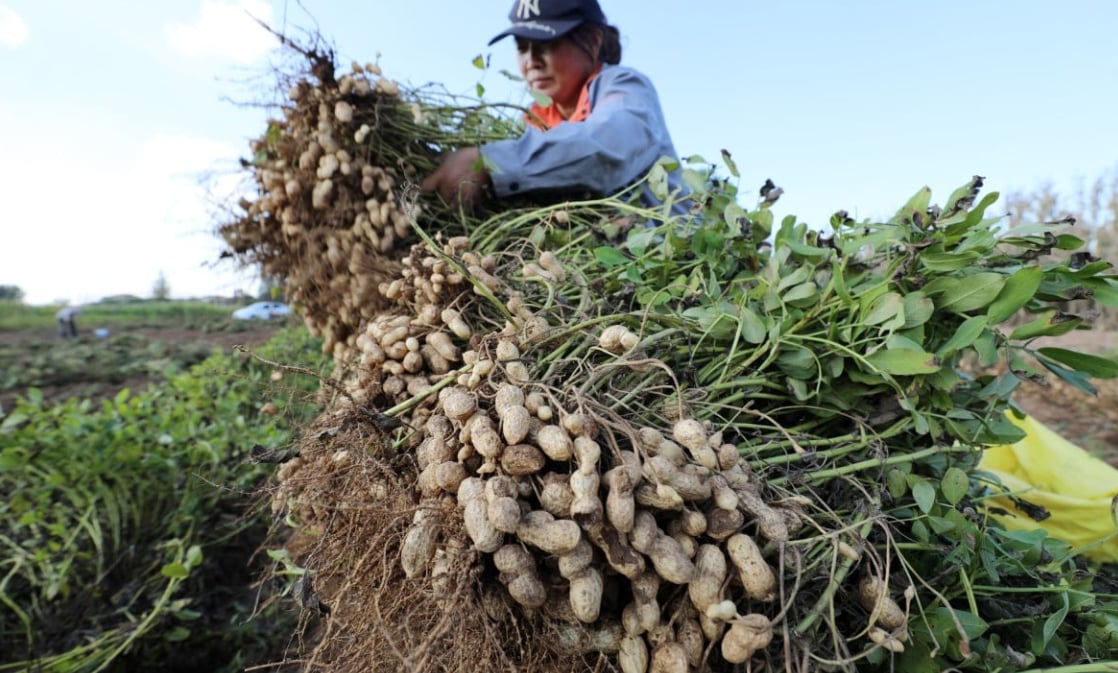November 25, 2025 | 22:51 GMT +7
November 25, 2025 | 22:51 GMT +7
Hotline: 0913.378.918
November 25, 2025 | 22:51 GMT +7
Hotline: 0913.378.918

A villager in Shannantou village, Shandong province sorts harvested peanuts on August 30, 2023. Agricultural and food self-sufficiency are a top priority for China’s government in the coming years. Photo: Xinhua
As progress continues on this front, here are some of the more notable achievements made in 2023 thus far.
China harvested its first crop of home-grown durians in late July from its southern tropical island of Hainan.
Though relatively small, the yield carried great symbolism. The tropical fruit, known for its potent smell, is mainly produced in Thailand, Malaysia and Vietnam.
The domestic durians were priced at around 120 yuan (US$16) per kilogram - about three times the cost of most imported durians - and their farming area was only 93.3 hectares.
As the world’s largest durian consumer market, China imported 825,000 tonnes of the fruit in 2022, according to customs data.
The Ministry of Agriculture announced in late August it would widen its trial of genetically modified (GM) corn and soybeans to 20 counties across five provinces.
It also started GM seed production in northwestern Gansu province this year.
In an article published in Farmers’ Daily, its official publication, the ministry attempted to ease public concerns that GM food may cause cancer and infertility by citing examples of its safe adoption in other countries. To ensure stable food production, the technology - which is estimated to increase corn and soybean yields by 5.6 to 11.6 per cent - could be essential.
China began exporting its home-grown white-feathered chicken to Tanzania in June.
The fast-growing, meaty breed represents nearly 50 per cent of China’s poultry production, according to the China Animal Agriculture Association.
Due to an avian flu outbreak in North America and a nosedive in the number of international flights, China reduced its reliance on the United States last year, according to a February report by Guosen Securities. The US is a major import destination for China’s breeder white-feathered chickens.
The introductory self-sufficiency rate of China’s “Shengze 901” breed increased from 10.56 per cent in 2021 to 25.82 per cent last year, the report stated.
China’s self-sufficiency rate in soybeans went up 3 percentage points last year, reaching 18.5 per cent according to the Ministry of Agriculture and Rural Affairs.
The world’s biggest soybean importer, China decreased its intake to 91.1 million metric tonnes in 2022, a drop of 5.6 per cent year on year according to China’s Ministry of Commerce.
Imports from the United States and Brazil, China’s two major sources of the crop, fell by 10 per cent and 6 per cent, respectively.
The ministry vowed to grow domestic soybeans at an annual rate of 7 per cent over the next decade and achieve a 30.7 per cent self-sufficiency rate by 2032. It made the pledge in its Agricultural Outlook Report for 2023-32, published in April.
China announced it had made a breakthrough in growing salt-tolerant rapeseed after a trial in the coastal Dongtai county of eastern Jiangsu province this June, according to a report released by China Science Daily, a newspaper affiliated with the Chinese Academy of Sciences.
This new species achieved a total of 323.87kg per mu harvested, which represents an increase of 59.5 per cent from the average yield.
Total oil production from the rapeseed could reach 163.17kg per mu, a theoretical increase of 82.7 per cent.
China has begun to develop seawater aquafarming in the inland Xinjiang Uygur autonomous region, raising freshwater fish, king prawn, abalone and lobsters.
The aquaculture firm Shi Shi Xian has developed a method to simulate seawater in its fishery on the edge of the desert using the region’s natural salinity.
China hopes to lift its aquatic production to 69 million tonnes by 2025, and the Xinjiang government is aiming to increase its own annual output to around 30,000 tonnes by the same year.
(SCMP)

(VAN) Brazil's COP30 presidency pushed through a compromise climate deal on Saturday that would boost finance for poor nations coping with global warming but that omitted any mention of the fossil fuels driving it.

(VAN) Poultry farmers in the UK have been warned that they could face one of the worst winters yet for bird flu.

(VAN) Prices of main-crop paddy have risen sharply, with jasmine rice hitting 16,100 baht per tonne — the highest level in years.

(VAN) In Brazil, FAO unveiled a series of reports and initiatives showing how sustainable agrifood systems are a solution to the climate crisis.

(VAN) With names like neodymium and dysprosium, rare-earth elements sound exotic — and their perceived scarcity has only added to the mystique.

(VAN) In a new study published in Trends in Biotechnology, researchers used a gene-editing technology called CRISPR to increase a fungus's production efficiency and cut its production-related environmental impact by as much as 61%- all without adding any foreign DNA.

(VAN) A top official in Beijing’s Cop delegation says China is committed to clean energy – but US’s absence is a problem.